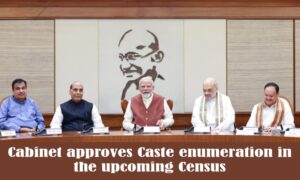Table of Contents
UN Peacekeeping Highlight
- They will provide relief and assistance to women and children, and perform security-related tasks as a part of the United Nations Interim Security Force (UNISFA).
- It will form part of an engagement platoon and specialise in community outreach.
- The platoon consisting of 27 women is part of an Indian Army battalion.
- It will be India’s largest single unit of women peacekeepers in a UN Mission since 2007 when the country deployed the first-ever all women’s police contingent in Liberia – it had 103 women.
- About Abyei: It’s an area claimed by Sudan and South Sudan.

Role of Women in Indian Peacekeeping
- India has been sending women personnel on UN Peacekeeping Missions.
- In 2007, India became the first country to deploy an all-women contingent to a UN Peacekeeping Mission.
- These women officers played a role in restoring security in the West African nation,
- Contributed to an increase in the number of women in Liberia’s security sector.
About United Nations Peacekeeping
- It is a joint effort between the Department of Peace Operations and the Department of Operational Support.
- Aim: To assist host countries to transition from situations of conflict to peace.
- It provide security as well as political and peacebuilding support to conflict-ridden countries.
- The U.N. began its Peacekeeping efforts in 1948 when it deployed military observers to West Asia.
- The three basic principles that guide U.N.’s Peacekeeping missions are:
- Consent of the parties
- Impartiality
- Non-use of force except in self-defence and defence of the mandate
- Responsibilities of U.N. military personnel
- Protecting civilians and other U.N. personnel
- Monitoring disputed borders
- Observing peace processes in post-conflict areas
- Providing security in conflict zones
- Providing security during elections
- Assisting in-country military personnel with training and support
- Assisting ex-combatants in implementing the peace agreements
- Global Contribution to Peacekeeping: A total of 119 countries have contributed military and police personnel to UN peacekeeping.
- Currently, 72,930 of those serving are troops and military observers, and about 8,890 are police personnel.
India’s Contribution to UN Peacekeeping

- India is one of the largest troop and police contributing countries to U.N. peacekeeping missions and more than 5,700 Indian peacekeepers are deployed in nine out of 12 U.N. peacekeeping missions at present.
- Since the 1950s, India has cumulatively deployed more than 260,000 troops to the missions.
- Through the years, 177 Indian peacekeepers have made the supreme sacrifice, the highest from any troop-contributing country.
- India is the fifth largest troop contributor (TCC) with 5,323 personnel deployed in 8 out of 13 active UN Peacekeeping Missions, of which 166 are police personnel.
- Major Contribution of Indian Troops
- Korean War, 1950s: India played mediatory role in resolving the stalemate over prisoners of war in Korea led to the signing of the armistice that ended the Korean War.
- UN entrusted the Indian armed forces with subsequent peace missions in the Middle East, Cyprus, and the Congo (since 1971, Zaire).
- India served as Chair of the three international commissions for supervision and control for Vietnam, Cambodia, and Laos established by the 1954 Geneva Accords on Indochina.
- Other Contribution by Indian Peace-Keeping Forces
- Medical Support: members of the Indian Formed Police Unit also organised medical camps for Liberians, many of whom have limited access to health care services.
- Veterinary Support: Indian veterinarians serving with the UN Mission in South Sudan (UNMISS), stepped up to help cattle herders who were losing much of their stock to malnutrition and disease in the war-torn nation.
- Skill Development: The Indian contingent in South Sudan has provided vocational training and life-saving medical assistance, as well as carrying out significant road repair work.
United Nations Military Observer Group in India and Pakistan (UNMOGIP)
- It was established on January 24, 1949 to supervise the ceasefire between India and Pakistan.
- UNMOGIP has remained in the region to observe hostilities between the neighbouring countries and report ceasefire violations along the Line of Control (LoC).
- India has reiterated that the mission has “outlived its relevance” after the Simla Agreement was signed by India and Pakistan in July 1972 and the establishment of the LoC.
UN Recognition to India Peacekeeping Efforts
- Indian contingent in the Upper Nile region have all received UN Medals of Honour.
- India had the honour of providing two Military Advisers, one Female Police Adviser, and one Deputy Military Adviser to the Secretary General of the United Nations.
- India was the first country to contribute to the Trust Fund on sexual exploitation and abuse, which was set up in 2016.
India’s Views on UN Peacekeeping
- India is of the view that the international community must grasp the rapid changes that are underway in the nature and role of contemporary peacekeeping operations.
- The Security Council’s mandates for UN Peacekeeping operations need to be rooted in ground realities and co-related with the resources provided for the peacekeeping operation.


 Cabinet Approves Caste Enumeration in th...
Cabinet Approves Caste Enumeration in th...
 International Labour Day 2025, Theme, Hi...
International Labour Day 2025, Theme, Hi...
 India-Canada Relations, Evolution, Recen...
India-Canada Relations, Evolution, Recen...





















